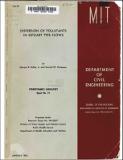| dc.contributor.author | Holley, Jr., Edward R. | en_US |
| dc.contributor.author | Harleman, Donald R. F. | en_US |
| dc.date.accessioned | 2022-06-13T13:12:44Z | |
| dc.date.available | 2022-06-13T13:12:44Z | |
| dc.date.issued | 1965-01 | |
| dc.identifier | 74 | |
| dc.identifier.uri | https://hdl.handle.net/1721.1/143054 | |
| dc.description | Prepared Under Research Grant, Division of Water Supply and Pollution Control Public Health Service Department of Health, Education and Welfare ; WP-00071 | en_US |
| dc.description.abstract | Much of the engineering literature has failed to show an understanding of the mechanism of longitudinal dispersion which arises in the one dimensional representation of pollution transport in turbulent shear flows. In the present work, it is shown that the one dimensional form of the mass balance equation may be obtained by spatially averaging the three dimensional mass balance equation. This averaging indicates that the convective transport cannot be represented in a one dimensional equation solely by the average velocity and average concentration at a section since there is a net transport associated with the variations of velocity and concentration from their averages. This net transport (called longitudinal dispersion) is shown to be diffusive in nature for uniform flow, and it is assumed to be diffusive for non-uniform flow. Thus, the mass transport due to dispersion is proportional to the longitudinal gradient of average concentration. The relative importance of dispersion depends on the relative steepness of the concentration gradient. A review is given of the procedures which have been used for modeling dispersion in estuaries. Investigation of the model laws, the dispersive mechanism, and model verification procedures indicates that model results on concentration distributions have been incorrectly transferred to prototype scale in the constant density regions of estuaries. It is shown that in distorted models concentration ratios are not numerically the same at geometrically similar points as has been assumed. This assumption has resulted in predicted concentrations which are an order of magnitude too large in many cases. An analytical method is presented for calculating the dispersion coefficient for uniform oscillating flow of the type found in constant density regions of estuaries. For turbulent estuary type flow in a uniform pipe of radius a, the analytical value of the dispersion coefficient is ... the shear velocity (square root of boundary shear stress divided by fluid density). Since u, is a periodic function of time, so is the dispersion coefficient. It is shown that after one or two periods of dispersal of mass, a sufficiently accurate concentration distribution may be obtained by use of a constant dispersion coefficient (Viz., the time average of the dispersion coefficient during a period of tidal oscillation). A mass balance equation representing conditions at "slack" times in an estuary is commonly used as a mathematical model for the distribution of a pollutant. The results of this investigation may be used to estimate the time averaged dispersion coefficient in this equation for constant density portions of tidal estuaries. Thus, preliminary estimates of concentration distributions may be obtained for known input conditions. | en_US |
| dc.publisher | Cambridge, Mass. : Hydrodynamics Laboratory, Dept. of Civil Engineering, Massachusetts Institute of Technology | |
| dc.relation.ispartofseries | Technical report (Massachusetts Institute of Technology. Department of Civil Engineering) ; 65-02. | |
| dc.relation.ispartofseries | Report (Massachusetts Institute of Technology. Hydrodynamics Laboratory) ; no. 74. | |
| dc.title | Dispersion of Pollutants in Estuary Type Flows | en_US |
| dc.identifier.oclc | 13894809 | |
| dc.identifier.aleph | 247657 | |
